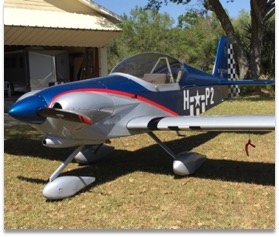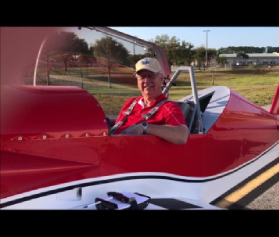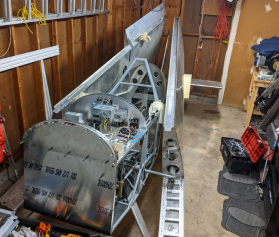The third and fourth test flight was completed on 4/29/2013 at Haller Airpark with a fuel stop at Palatka, FL.. The departure time was 0950 with 14 gallons of fuel. Winds were light and temperatures in the low 70s.
A normal takeoff with the first notch of flaps was accomplished and a 90-100 mph climb to 4500 feet over the airport. The first 30 minutes was spent doing slow flight, stalls and less than one turn spin entries. All reactions noted on the second test flight were repeatable and the aircraft handling continues to be very predictable. Low speed manners are excellent and all transitions from a stalled condition to flying were excellent.
During the second sortie a series of continuous aerobatics were completed. This involved consecutive loops, barrel rolls, spit S, clover leafs and aileron rolls. Various amounts of rudder were introduced during the rolling maneuvers to check increases in roll rate. A small amount of rudder did assist in the roll rate only if it was lagging behind the aileron input. Too much rudder appeared to slow the roll rate down. This is a nice rolling airplane and if full deflection is held the roll rate is excellent.
During the loops, four consecutive loops where completed starting with an entry speed of 140 mph and ending with an entry speed of 110 mph. The aircraft would pull over the top with a constant power setting of 2500 RPM with about 2.4 to 2.6 Gs. The 110 mph loop saw an indicated airspeed on the top of 35 mph with no stalling indications at one G. At the top of the last loop with the speed indicating around 40 mph full aft stick was initiated. The result was an increase in nose track to the vertical line with no indications of a stall or wing drop. A slight burble was noted as the airspeed increase and by relaxing back pressure the aircraft accelerate without any indications of a stall.
After 35 minutes of flight time, the aircraft was flown to Palatka, FL for a normal full stop landing on hard surface. Landing was into to a 10 mph headwind with full flaps. After a normal wheel landing the aircraft was allowed to roll out without brakes to allow the tail to settle into the three-point attitude at the slowest speed. The transition was straight with good rudder control. No tendency to drift to the left or right was noted. With the direct steering tail wheel, when it contacts the runway the reaction to any rudder input is quick and required a gentle application of rudder.
Twelve gallons of fuel was added and a normal no flap departure was completed with 20 gallons total. The remainder of the flight was normal flight activities with some time spent working the MGL extreme unit.
A normal pattern was flown to a three-point landing. The airspeed on final was accomplished at 60 MPH indicated with power reduction to idle at the 25 foot point. Control during the flare and establishment of the three-point attitude saw smooth progressive elevator input. A full stall landing was accomplished and the airplane stalled with very little indication just prior to touchdown. A full stop taxi back was completed and the landing pattern repeated.
Control and response during all pattern work is precise and shows no abnormal indications or bad habits. With the slow approach speeds and positive ground tracking, it is a pleasure to fly.
– Bob Woolley – Team Panther Sport Version Beta Builder



